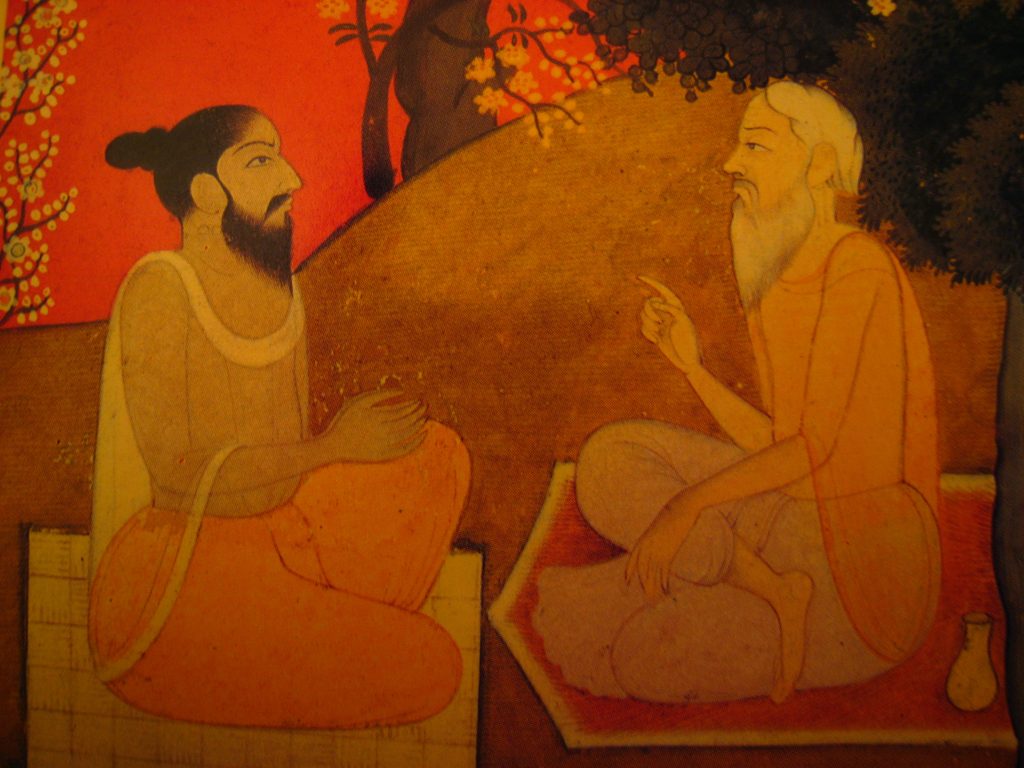The earliest form of Hindu tradition occurred during the Vedic period in Indian history.1 The Upanishads, works of philosophical thought, were a major contribution to the development of Hinduism, taking place long after the Aryan migrations to the Indus and Ganges River valleys and their subsequent interaction with the Dravidian inhabitants. Although Hinduism has no established founder, it is one of the first forms of religious practice, dating back to at least 1500 B.C.E., making it one of the world’s most important and oldest world religions.

The word Hindu is derived from shindhu, the ancient name for the Indus River, where the Aryans are supposed to have first established themselves. Therefore, the name Hinduism could have been influenced by the geographic location of the Aryans, the first to practice Hindu philosophical thought. Early Indo-European migrations, starting around 1500 B.C.E., led the Aryans to enter India and settle in the Punjab region of the Indus River Valley. There they met Dravidians, an already established people, descendants of the earlier Harappan civilization. Although the Aryans were in constant conflict with the Dravidians, and among themselves as well, the Aryans learned agricultural techniques and possibly belief systems from the Dravidians. Eventually, these two groups merged into one culture, combining ideas from the Dravidians with ritual practices from the four Vedas of the Aryans, forming the foundations of Hinduism.
During the Vedic Age, from roughly 1500 to 500 B.C.E., Aryan beliefs were contained in the four Vedas, the oldest of which was the Rig Veda, which mentions their chief deity Indra. He was a violent god, leader of battles and the god of war. Aryan beliefs included sacrifices to other gods too, such as the gods of sun, sky, moon, fire, health, and disease. The purpose of their sacrifices was to ensure victory in wars and military success. Ethics remained a minor aspect of religious practice during the Vedic Age and in the Aryan religion. The beginnings of Hinduism occurred with a popular dissatisfaction with the practice of sacrifices. Individuals sought after a more intimate and meaningful relationship with their gods.2

Along the Ganges river valley, around 800 B.C.E., many individuals began to contemplate the deeper spiritual understanding of the Vedas. Many of these thinkers attracted disciples, and while studying the practices established by the orally transmitted works and characteristics of the Vedas, the teachings of these individuals became the collected writings known as the Upanishads.
Wisdom and knowledge was achieved with the Upanishads in the years between 800-400 B.C.E. Throughout these works, the principle of Brahman, the universal and eternal soul, is explained. In an excerpt from the Katha Upanishad, Brahman is shown to be the Creator:
The all-knowing Self was never born, Nor will it die. Beyond cause and effect, This Self is eternal and immutable. When the body dies, the Self does not die.” —Katha Upanishad
Dravidians had believed in a form of reincarnation, which became one of the main concepts within Hinduism. It is the belief that souls of individuals, or one’s Atman, is actually of the same substance as the universal soul, Brahman. The idea of Atman can be see in the following excerpt from the Katha Upanishad:
There are two selves, the separate ego and the indivisible Atman. When One rises above I and me and mine, the Atman is revealed as one’s real Self. —Katha Upanishad
The Atman seeks to reunite with Brahman, but is hindered from merging with Brahman through ignorance, requiring multiple cycles of reincarnation, or samsara, in order to come to the understanding that one’s Atman is eternal with the Self or Brahman. This learning process is based on the practice of karma, which is rewarded by practices of good deeds, self-control, honesty, and charity while avoiding greed and envy. The ultimate goal was moksha, which was the final release from the cycle of samsara with the merging of one’s Atman with Brahman. The following excerpt in the Kena Upanishad shows the possible merge of the individual soul with Brahman:
Those who realize Brahman shall conquer All evil and attain the supreme state. Truly they shall attain the supreme state!” —Kena Upanishad
Moksha, the dreamless sleep that came with permanent liberation of human pain and suffering, was thought to be achieved through meditation and asceticism. This is the practice of living a simple life and denying all worldly pleasures.3
Today, Hinduism is the world’s third largest religion after Christianity and Islam.4 The Indian efforts to achieve understanding of the world through nature and philosophical thought served as a bridge to the development of Hinduism from the Vedic Age. The Upanishads, through the concepts of Brahman, Atman, samsara, karma and moksha, allowed for a new beginning in society’s understanding of the spiritual world.
- Ancient History Encyclopedia, (2009-2016), s.v. “Religion Timeline.” ↵
- Jerry H. Bentley, Herbert F. Ziegler, Traditions and Encounters: A Global Perspective on the Past Volume 1: From the Beginning to 1500 (New York, NY: McGraw-Hill, 2011), 76-78. ↵
- Jerry H. Bentley, Herbert F. Ziegler, Traditions and Encounters: A Global Perspective on the Past Volume 1: From the Beginning to 1500 (New York, NY: McGraw-Hill, 2011), 80-82. ↵
- Religious Tolerance, December 2015, s.v. “Religions of the world: Numbers of adherents of major religions, their geographical distribution, date founded, and sacred texts,” by B.A. Robinson. ↵



37 comments
Samuel Ruiz
It is amazing that there are many articles relating to topics in class. I found this one to be most interesting so far since I recently learned about the Upanishads. It is nice to read about beliefs and religions of ancient groups. The Brahman, or universal soul, is most interesting to me because it is a different view of life, other than my own views from Catholicism.
Olga Perez
I’ve always thought that learning about other religions is both essential and entertaining. I think to better coexist, we, as a society should about each other a little bit more. Just in general though, Hinduism is so fascinating to me. I like the concept of reincarnation, karma and moksha. I hadn’t heard of moksha before this article, so that really cool to learn about. Also the history and where the name Hindu was derived from was really interesting to read about and to expand my knowledge.
Josemaria Soriano
Personally, this article has seemed to me very useful, philosophically speaking. The vast majority of the Western Hemisphere is of Christian religion, and many times as Christians we make the often unconscious mistake of disparaging other religions. What do I mean? We usually describe Hinduism as a “primitive” and often “uncivilized” religion, because it is a polytheistic religion whose images often feature gods with animal representations, such as Ganesh, represented by an elephant. And this ridiculous prejudice makes us discard deep philosophical knowledge within Hinduism, something that this article effectively rescues. In fact, the Upanishads present a very interesting idea of the soul, a common soul to all creation, which makes everything interconnected. On the other hand, it defies the Christian perspective of the “new life” as a good thing, describing it as a punishment. No religion has the absolute truth, and one can not blind oneself to a knowledge of centuries developed by other cultures. My sincere congratulations to the writer.
Ashley Tumlinson
This was an extremely well written article! To be quite honest, before I read your article I wasn’t very familiar with Hinduism. I knew of its existence, however I was unaware of the significance it upheld throughout our world. The factual evidence in this article was very helpful in understanding just how much this particular religion has evolved since the Vedic period of Indian history! I think you did a great job at keeping the reader intrigued throughout the entire writing, as well as through your choice of illustrations!
Maria Callejas
Great article! Shout out to your amazing information, this was definitely a learning session for me. I had no idea that Hinduism emerged when the Dravidians and Aryans merged together. I am not surprised people disliked the early Hindu rituals if there is no ethics being involved, why even bother? I think it is crucial for everyone to understand the origins of one of the biggest religions to date and their thirst for the philosophical understanding of the world. Also, your third image is amazing, that quote really portrays the teachings and messages the Upanishads give.
Rebekah Esquivel
I did not know much about Hinduism before reading this article. The most I knew was that it was an Indian religion and they did not eat cows due to them being a sacred animal. I can tell it took a lot of research to develop this article and getting accurate research that made sense had to have taken you a lot of time. I did not know that the name Hindu came from Shindu which is the name of the Indus River. I also was unaware that Hinduism was the third largest religion in the world today. This article was very informative and taught me a lot about Hinduism.
Alexis Renteria
Before reading this article I wasn’t too familiar with Hinduism, and I found it interesting that it was founded by two different groups of people. I was also surprised to learn that these same groups of people had conflicts and eventually they came together to establish Hinduism. Overall this was a very interesting informative article, and I was able to gain a deeper understanding of one of the worlds most practiced religions.
Crystalrose Quintero
I enjoyed the third image. It was a perfect example of they types of writings the upanishads documented. It also reflects how the upanishads are viewed which is filled with wisdom and knowledge. I also appreciated that it explained some principles and beliefs that the upanishads had; but it was able to provide a quote to follow and went in depth on explaining how this demonstrates their beliefs.
Steven Clinton
Great article. I never knew Hinduism was formed from two different ethnic groups. Hinduism seems to have the best of both worlds in regards to the beliefs of the Dravidians and the Aryans. It’s interesting how two groups came together because originally, they were in constant conflict with each other. With diplomacy by trade, the were able to put aside their differences and merge as one.
Hayden Hollinger
This was a very well written article that made good use of the sources. I did not know much about Hinduism prior to this article but feel like I have a solid understanding after reading this. I liked the detail that the article went into by looking at the religion from different points of view. I also enjoyed learning about some of the theological beliefs.